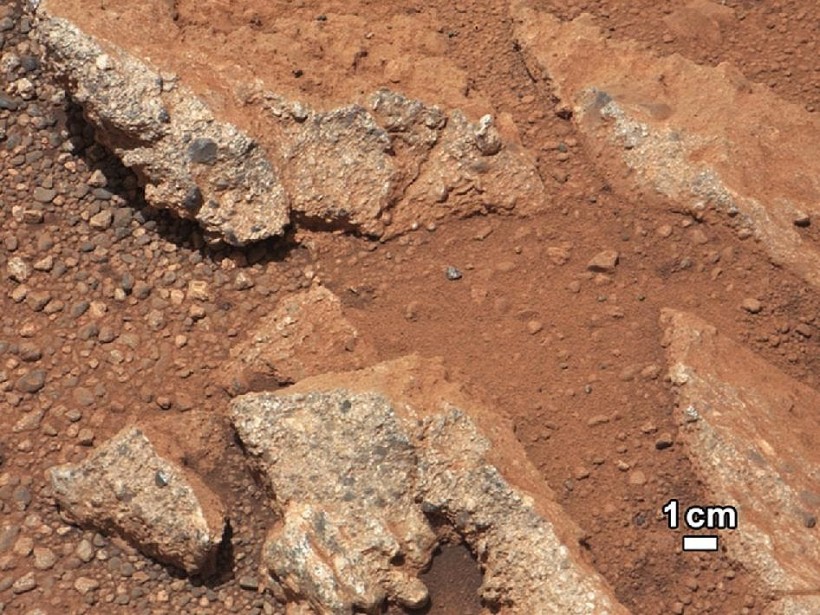The NASA photos which have captured the possible life on Mars featuring growing fungi are off the charts. However, the claims reported that the fungi are flourishing on the red planet, but scientists said that is not the real case.
Previous Report About NASA Photos Showing Mushroom on Mars

IN SPACE - SEPTEMBER 2: In this handout image provided by NASA/JPL-Caltech/MSSS, and captured by NASA's Curiosity rover, a rock outcrop called Link pops out from a Martian surface that is elsewhere blanketed by reddish-brown dust, showing evidence for an ancient, flowing stream, September 2, 2012. The fractured Link outcrop has blocks of exposed, clean surfaces. Rounded gravel fragments, or clasts, up to a couple inches (few centimeters) in size are in a matrix of white material. Many gravel-sized rocks have eroded out of the outcrop onto the surface, particularly in the left portion of the frame. The outcrop characteristics are consistent with a sedimentary conglomerate, or a rock that was formed by the deposition of water and is composed of many smaller rounded rocks cemented together. Water transport is the only process capable of producing the rounded shape of clasts of this size.
In the latest article written by UNILAD, the scientists believed that there is an actual life thriving on the red planet at the moment. This theory is venturing on Mar's viability to be a living planet to some life forms.
Dr. Rudolph Schild, Dr. Xinli Wei, and Dr. Rhawn Gabriel Joseph created the theory after conducting a study on the images generated by NASA's Curiosity rover.
The usual headline that we see such as "NASA Photos Prove There Is Life On Mars" is an eye-catching phrase that will hook the readers to be enticed in such discovery.
However, the error in some articles reporting about the possible life on Mars infrequently incorporates scientific evidence to support the claims.
Read Also: NASA Rocket Black Brant XII Launch is Visible to the Naked Eye: Here's Where You Need to Look
The bad science paired with publicity could spell misinformation that should be avoided at all costs.
The Bad on the 'Mushroom on Mars' Theory
Joseph is one of the scientists who theorize that the fungi on Mars could indicate a possibility of life on the planet. On his brainmind.com website, it states there that he has contributed a lot in the field of neuroplasticity during the 1970s.
Joseph has been publishing claims for more than 10 years. Mainly, they are all about pseudo-scientific findings that he had written in his journals.
Oftentimes, his studies have managed to reach the press, but on a scientific note, experts often criticized the legitimacy of his scientific journals in the field of space science.
CNET reporter Jackson Ryan has previously published an article about Joseph's claims. Moreover, it even reached the point that experts renounced the articles and suggested that it should undergo "critical assessment" and "proper" literature citation.
Yet in another instance, his claims have been published in the Advances in Microbiology journal. The said journal is involved in the malicious copying of scientific articles in different sites, Nature reported. This means that papers do not undergo quality checks before being officially published.
Joseph's new paper entitled "Fungi on Mars? Evidence of Growth and Behavior From Sequential Images" deals with the possible life on the red planet through the help of an "inaccurate" methodology for the deduction.
Together with his co-authors, Joseph made use of NASA photos to conclude that the fungal growth on Mars translates to a possible living.
"Claiming that mushrooms are sprouting all over Mars is an extraordinary claim that requires better evidence than an analysis of photographic morphology by a known crank who has claimed, on the basis of the same kind of analysis, that he has seen fields of skulls on Mars," the University of Minnesota Morris biologist Paul Myers said.
Myers has been keeping a track of Joseph's previous activities.
As per the scientists' statement, the majority of them came up with the agreement that the Mars' surface is not an ideal location for the mushroom to grow.
On top of the report, scientists' and researchers' confidence in their studies could be impacted by the misinformation that quickly spread these days.
For Australian astrobiologist, Brendan Burns, all available evidence says that the red planet's surface is difficult to live in.
The people should be careful in reading what they believed in. In the long run, it could damage the reputation of the scientists as well as the big organizations like NASA, which are dedicated to carrying out a study to find legitimate signs of life on another planet.
Related Article: NASA Photos Show 'Mushroom' Fungus Growing on Rocks in the Red Planet-Is There Life on Mars?
This article is owned by Tech Times
Written by Joseph Henry









